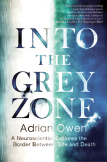Understanding what consciousness is, and why and how it evolved, is perhaps the greatest mystery known to science. With its 100 billion or so neurons and a processing rate of about 4 billion bits per second, the human brain is a miraculously complicated entity, much of which is still under scientific investigation. In a new book, Into the Grey Zone: A Neuroscientist Explores the Border Between Life and Death, renowned neuroscientist Adrian Owen, PhD, explores one of the least understood scientific frontiers—the twilight region between full consciousness and brain death.
Controversial Grey Zone
BOOKMARK

- Title: Into the Grey Zone: A Neuroscientist Explores the Border Between Life and Death
- Author: Adrian Owen, PhD
- Publisher: Simon & Schuster
- Publication Date: June 2017
- Price: $28.00, hardcover, 320 pages
CURRENTLY THE Canada Excellence Research Chair in Cognitive Neuroscience and Imaging at the Brain and Mind Institute, Western University, Canada, Dr. Owen is well known in the field, and his work has been featured in most major U.S. media outlets and medical journals. The “grey zone” is a middle region, of sorts, populated by people who have sustained traumatic brain injuries or who are victims of stroke or degenerative diseases such as Alzheimer’s and Parkinson’s diseases. Many of these patients are unaware of the world surrounding their bodies, but, as Dr. Owen notes, quite a few—as many as 20%—have intact minds trapped within their damaged brain and bodies. Dr. Owen came to prominence in 2006, when he led a team that discovered this 20% or so lost population of patients and in the process provoked furious debate among the medical and scientific communities about the meaning, value, and ultimate purpose of life.
Plumbing the Depths, Reconnecting People
READERS WHO ENJOYED Dr. Oliver Sacks’ Awakenings and The Man Who Mistook His Wife for a Hat will have a rewarding cover-to-cover experience with Into the Grey Zone. As in most good trade publication science books, Into the Grey Zone has a narrative pacing that keeps the reader engaged in each page and firmly embedded in the struggles of the scientists and their subjects.
The book is organized into 15 chapters, each using different types of case studies to elucidate the unique challenges faced by patients in the “grey zone.” Those well versed in technology will find much to enjoy here, as elegant experiments and dazzling new technologies are on display. But beyond the science, Dr. Owen’s clear mission is to plumb the mysterious depths of people who have been lost in the grey zone and find ways to reconnect them to the world and their loved ones. There are triumphs as well as deeply disturbing failures.
“Dr. Owen’s clear mission is to plumb the mysterious depths of people who have been lost in the grey zone and find ways to reconnect them to the world and their loved ones.”— Ronald Piana
Tweet this quote
Dr. Owen writes: “I’d been watching Amy for almost an hour when she finally moved. She had been sleeping when I arrived at her bedside in a small Canadian hospital, a few miles from Niagara Falls. It seemed unnecessary, even a little rude, to wake her. I knew there was little point in trying to assess vegetative-state patients when they are half asleep. I peered into her eyes, and all I saw was emptiness.”
So begins a medical drama. Amy was a smart college student and a star basketball player until one day an assault by her jilted ex-boyfriend left her brain-damaged and vegetative. At this point, her two doctors suggested taking her off life support. Naturally, her parents were stricken and confused. However, her parents signed a consent form, allowing Dr. Owen to transport Amy back to his hospital to perform a functional magnetic resonance imaging. In short, after 5 days of intensive investigation, “we found that Amy was more than just alive; she was entirely conscious.” After heroic interventions and a lot of intensive therapy and drugs, Amy “became a person again.”
New Technologies Offer Hope
IT IS DIFFICULT, even for the most cynical of us, not to love stories like that. And this book is full of them, each with a different medical twist. In the book’s final chapter, “Reading Minds,” Dr. Owen takes the reader on a trip into the near future, when we will have so-called brain-computer interfaces, which, among other things, will allow physicians to map, augment, or repair human cognitive or sensory motor functions.
The technology in this book is wondrous, but for Dr. Owen, in the end it’s all about the patient. “What began as a scientific journey more than 20 years ago evolved into a different kind of journey altogether: a quest to pull people out of the grey zone, so they can once again take their place among us in the land of the living.”
An interesting and rewarding read, Into the Grey Zone is recommended for readers of The ASCO Post. ■

